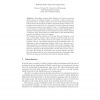Free Online Productivity Tools
i2Speak
i2Symbol
i2OCR
iTex2Img
iWeb2Print
iWeb2Shot
i2Type
iPdf2Split
iPdf2Merge
i2Bopomofo
i2Arabic
i2Style
i2Image
i2PDF
iLatex2Rtf
Sci2ools
CRYPTO
2000
Springer
2000
Springer
Sequential Traitor Tracing
Traceability schemes allow detection of at least one traitor when a group of colluders attempt to construct a pirate decoder and gain illegal access to digital content. Fiat and Tassa proposed dynamic traitor tracing schemes that can detect all traitors if they attempt to rebroadcast the content after it is decrypted. In their scheme the content is broken into segments and marked so that a re-broadcasted segment can be linked to a particular subgroup of users. Mark allocation for a segment is determined when the re-broadcast from the previous segment is observed. They showed that by careful design of the mark allocation scheme it is possible to detect all traitors. We consider the same scenario as Fiat and Tassa and propose a new type of traceability scheme, called sequential traitor tracing, that can efficiently detect all traitors and does not require any real-time computation. That is, the marking allocation is pre-determined and is independent of the re-broadcasted segment. This is...
Related Content
| Added | 02 Aug 2010 |
| Updated | 02 Aug 2010 |
| Type | Conference |
| Year | 2000 |
| Where | CRYPTO |
| Authors | Reihaneh Safavi-Naini, Yejing Wang |
Comments (0)

